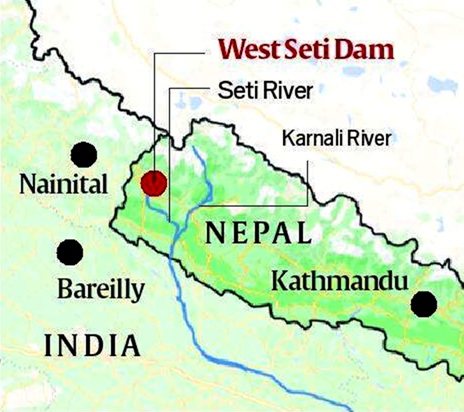Prelims: (Geography + International Relations + CA)
Mains: (GS 2 – Bilateral Relations, GS 3 – Infrastructure/Energy) |
Why in the News ?
Nepal has extended the survey license deadline for the West Seti Hydropower Project being developed by India’s NHPC. It has also approved work for a direct agreement for another project by SJVN, aiming to facilitate Indian power companies in executing hydropower projects in the Himalayan nation.

About West Seti Hydropower Project

- It is a 750 MW hydroelectric storage project on the Seti River (a tributary of the Karnali River) in Nepal.
- Unlike typical run-of-river hydropower plants, West Seti is designed as a storage-based project with a large reservoir.
- Water can be stored during the monsoon season to generate steady electricity throughout the year, including dry months.
- The project is being developed by India’s National Hydro Power Corporation Ltd. (NHPC) under a Public-Private Partnership model.
Core Infrastructure Includes
- A 195-meter-high concrete-faced rockfill dam.
- A reservoir approximately 25 km long, submerging parts of the river valley and nearby forest areas.
- An underground power station and associated power transmission lines for electricity evacuation.
- Annual Energy Generation: ~3,636 GWh.
- Ownership and development follow a PPP model led by NHPC.
Power Purchase Agreement (PPA)
- Nepal will receive 21.9% free electricity from the project.
- The remaining generated electricity will be exported to India via Power Trade Corporation India Ltd.
Significance of the Project
- Enhances India–Nepal hydropower cooperation.
- Helps Nepal strengthen its energy security and boost electricity exports.
- Supports year-round grid stability due to storage capability.
- Creates local employment and infrastructural development in far-western Nepal.
Challenges
- Resettlement and rehabilitation issues due to the large reservoir area.
- Environmental concerns related to valley inundation and forest submergence.
- Engineering complexities of constructing a high dam in a seismically sensitive Himalayan region.
- Involvement of multiple agencies requiring regulatory coordination.
Impact
- Boost to Nepal’s hydropower production capacity.
- Strengthened India–Nepal ties in the energy sector.
- Long-term revenue generation for Nepal through power exports.
- Potential ecological and social impacts on communities living in the reservoir region.
|
FAQs
Q.1. Is West Seti a run-of-river project?
No. It is a storage hydropower project with a large reservoir.
Q.2. Which river hosts this project?
The Seti River, a tributary of the Karnali River in Nepal.
Q.3. Who is developing the project?
NHPC Ltd. of India, through a Public-Private Partnership model.
Q.4. How much free electricity does Nepal receive?
21.9% of the generated power.
Q.5. Which UPSC subjects can ask questions on this topic?
Geography, International Relations, Infrastructure, and Environment.
|



